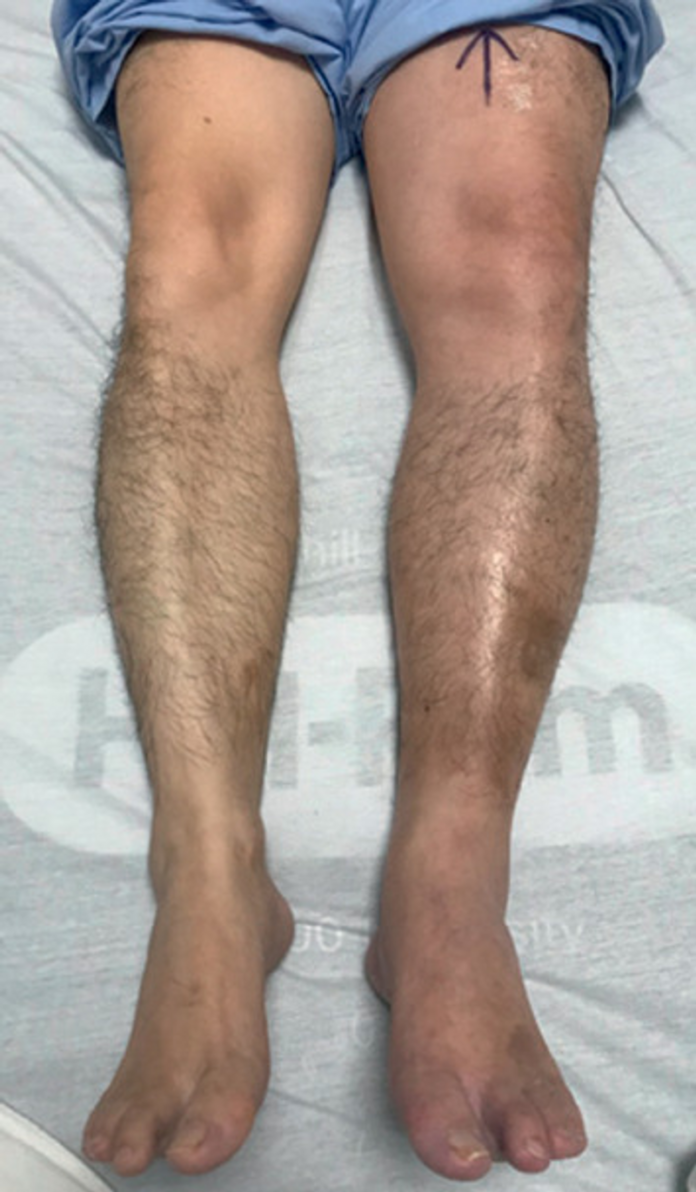- May-Thurner Syndrome is an overlooked cause of deep vein thrombosis (DVT). Similarly, the clinical prevalence is likely underestimated.
- The condition is more prevalent in females aged between 20–50 years.
- This case describes MTS-related extensive iliofemoral DVT occurring in a middle age male.
A 63-year-old Chinese patient presented with progressive left lower limb swelling and pain with a history of 4 days. There was no trauma history. This was the first time he was experiencing these symptoms. His past medial history was remarkable of hypertension and hyperlipidaemia. He was not on any long-term medications for the comorbidities. He had no family history of DVT. In addition, he also hadn’t been on any long haul flights recently. Neither did he have a history of immobilisation. He was working 10-hour shifts as a private care hire driver. And had no history of smoking. The findings were consistent with the diagnosis of “May–Thurner Syndrome”.
Examination and diagnosis
On presentation the patient was afebrile and appeared comfortable with normal vitals and oxygen saturation. In addition, there were no significant findings on cardiovascular and respiratory examinations. The patient’s lower left limb was warm and mildly tender with a 4 cm swelling up to the mid thigh. However, there were no signs of stasis dermatitis, varicosities, or phlegmasia cerulean or alba dolens. Moreover, his peripheral distal pulse was palpable.
Lab work including full blood count, renal panel and coagulation profile were all normal. Fasting glucose was negative for diabetes. ECG showed sinus rhythm with no heart strain. Doppler compression ultrasound of the left lower limb showed partial DVT that extended from the external iliac (EIV) and common femoral (CFV) to the popliteal veins. Doctors advised a contrasted CT of the thorax, abdomen and pelvis in view of the aggressive nature of the thrombosis. It ruled out an intrabdominal pathology. In addition, to look for pulmonary complications in the same setting. CT showed compression of the left common iliac vein (CIV). There was no filling defect in the IVC. However, the right upper lobe and lower lobe pulmonary arterial lobar/segmental branches were remarkable for filling defects.
The findings ruled out a pelvic mass and were suggestive of May-Thurner syndrome.
Treatment
Initial treatment included LMWH enoxaparin. Doctors advised left lower limb AngioJet pharmacomechanical thrombolysis/thrombectomy with iliac vein stenting and insertion of a temporary inferior vena cava (IVC) filter. The patient showed significant improvement in symptoms after the procedure. The swelling and pain in his left lower limb also improved. His was given an oral Factor Xa. After a month of discharging the patient, he remained well. Repeat ultrasound showed stent patency. Therefore, he was advised an elective IVC filter retrieval. The procedure was uneventful. His next follow-up was for a year later.
References
May–Thurner Syndrome: A Consideration for Deep Vein Thrombosis in Males https://www.ncbi.nlm.nih.gov/pmc/articles/PMC7267864/




